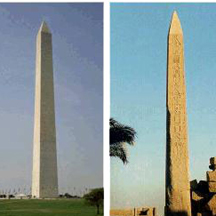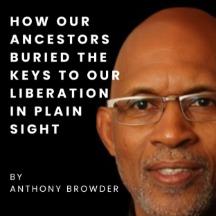After nearly 50 years of studying ancient African civilizations and their influence on modern America, I've come to understand something profound about the nature of knowledge preservation. What looks like cultural destruction and historical erasure is actually part of a much larger strategy—one that our ancestors orchestrated thousands of years ago.
They knew the fall was coming. And they prepared for the rise. This is something that's taken me decades to fully comprehend.
The Strategic Burial of Ancient Wisdom
When I look at the symbols scattered throughout Washington DC—the Egyptian tekhen (obelisk) we call the Washington Monument, the pyramid on our dollar bill, the sacred geometry embedded in the city's layout—I no longer see these as mere coincidences or even simple appropriation.I see a preservation system.
Think about it this way: if you knew your civilization was going to face a period of decline, what would you do with your most precious knowledge?
You'd hide it where your descendants could find it when they were ready to reclaim their power. You'd bury treasure maps in plain sight.
By burying essential information in symbols, structures, and stories that would be preserved by the very people who conquered them, they ensured that the tools for liberation would survive the darkest periods.
When the Masons who designed this nation's capital, stole African knowledge, they were unknowingly becoming custodians of it. They surrounded themselves with our symbols, thinking they were harnessing their power for themselves alone. But symbols carry more than just energy.
They carry memory.
The Movie That Revealed Everything
There's a scene in Ryan Coogler's film "Sinners" that crystallized this understanding for me.The character Smoke is about to confront the Ku Klux Klan. Before the final battle, he buries a box filled with weapons. After taking out the main targets with his sniper rifle, he returns to unearth his tommy gun and finishes the job.
That's exactly what's happening now.
We're in the phase where African men and women are unearthing treasures that have been buried right in our own backyard. The tools for mental liberation, spiritual awakening, and systematic change have been waiting under our feet this entire time.
The 100-Year Awakening Cycle
The timing of this awakening isn't random. We're living through the 100th anniversary of Arthur (Arturo Alfonso) Schomberg writing "The Negro Digs Up His Past" in 1925. Think about the significance of that title and this moment. We are literally and figuratively digging up our past right now.When a 17-year-old John Henrik Clarke read that article, it inspired him to jump on a freight train to Harlem. He marched into Schomberg's office with youthful arrogance and demanded to be taught everything.
Schomberg just laughed.
"Boy," he said, "go and learn about your enemy. Study your enemy, then study yourself, then study the world that your enemy created. Then come back to me with that knowledge so we can have an intelligent discussion."
That advice created one of the greatest historians of our time. But more importantly, it established a pattern for how buried knowledge gets transmitted across generations.
The Pattern of Preservation
The burial strategy works in 5 Phases:Phase 1: The Seeding (Ancient Kemet) Ancient knowledge was embedded in symbols, architecture, stories, and systems during periods of African influence and power.
Phase 2: The Concealment (Greek/Roman Conquests - 1700s) As power structures shifted, this knowledge became hidden and was appropriated by others who understood its value but not necessarily its origin.
Phase 3: The Forgetting (The Maafa/Transatlantic Slave Trade) Multiple generations passed where the descendants of the original knowledge holders lost conscious connection to their heritage.
Phase 4: The Awakening (Harlem Renaissance - Civil Rights Era) Individuals began to notice patterns, question narratives, and start digging deeper into hidden meanings.
Phase 5: The Reclamation (Present) The buried treasures are being unearthed, understood, and used to restore power to their rightful inheritors.
We're moving into Phase 5 right now.
Hidden in Plain Sight: The Washington Monument
Let me walk you through how this preservation system works using the most obvious example.Standing in the geographical center of America's capital is a 555-foot tall Egyptian tekhen (obelisk). They call it the Washington Monument, but that's just the public name. Inside, is evidence that it was actually dedicated to Asar (Osiris), the first king of ancient Kemet.
Why would white Masonic founders place a 6,000-year-old African resurrection symbol at the heart of their new nation? The surface answer is that they were appropriating its power for themselves. But the deeper truth is that they were unknowingly preserving it for us.
Laws mandating that no structure in DC can be taller than that obelisk ensures that this symbol of African resurrection remains the highest point in American governmental power.








